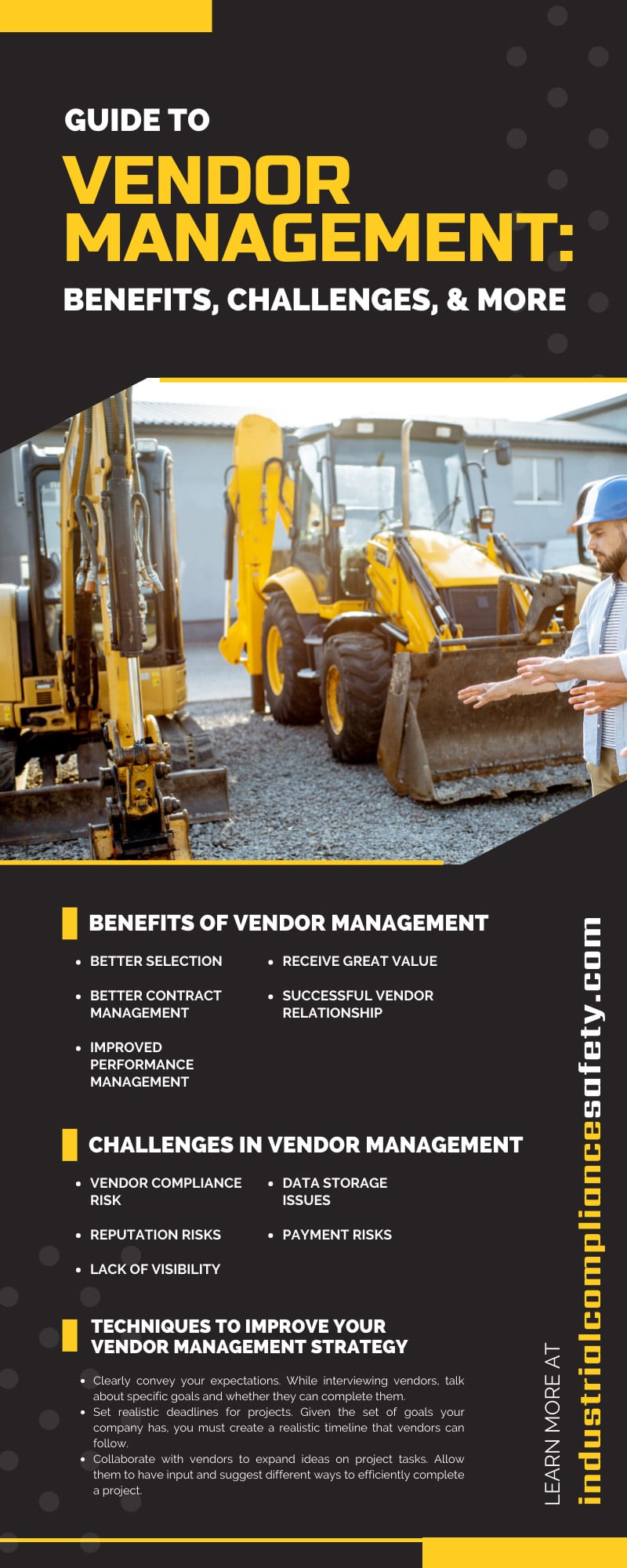Vendor management plays an important role in project completion. Sometimes, you need outside help to finish a job. That’s where vendors come in. Not all vendors are the same, selecting the right ones is important to make sure things run smoothly. Learn more about vendor management, its benefits, and how they can help your business grow. At Industrial Compliance & Safety we work with contractors of all sizes to help them with their safety compliance and safety certification needs so that they can focus on growing their business.
What Is a Vendor Management System?
Vendor management is the process of enlisting vendors to help execute projects within your company. It’s a process that includes practices like controlling costs, tracking, reviewing, and aligning the vendor’s goals with your organization to ensure a profitable partnership.When onboarding a vendor, both parties must sign a vendor agreement that defines their relationship and clear expectations. The agreement reduces the chance of a misunderstanding or failure to complete a project.
Benefits of Implementing a Vendor Management System
By implementing a vendor management system, businesses can experience the following benefits:
- Better Selection
When you have appropriate vendor management, your business can benefit from a large selection of vendors to choose from. As a result, you can narrow down a vendor selection instead of struggling to find candidates.
- Better Contract Management
If you enlist multiple vendors, you need a proper vendor management system that holds documentation, contracts, and other important information. Your company can benefit from a management system that centralizes the status of vendor contracts.
- Improved Performance Management
Along with better contract management, a vendor management system can provide a view of project performance done by multiple vendors. You can track efficiency and understand what’s working and what’s not.
- Successful Vendor Relationship
It can be challenging to work with multiple vendors at the same time. However, it’s important to establish a successful relationship to complete projects. Once the project is complete, you can keep the vendor in your contacts for future projects or refer them to other companies.
- Receive Great Value
The ultimate goal of vendor management is getting your money’s worth of work. By selecting the right vendors, your company will have the assurance that you’re receiving quality service and great value.
How to Choose Vendors
Thoroughly Research and Identify Potential Vendors:
- Investigate and compile a list of prospective vendors
- Analyze vendor profiles, expertise, and capabilities
Obtain Comprehensive Price Quotes:
- Request detailed quotes to understand pricing structures
- Clarify cost breakdowns and potential additional charges
Evaluate Turnaround Time:
- Assess projected delivery times to align with your project schedules
- Ensure the vendor’s ability to meet time-sensitive demands
Scrutinize Past Performance:
- Investigate vendor track records, reviews, and testimonials
- Gauge consistency, reliability, and quality of past projects
Cultivate Effective Vendor Relationships:
- Establish transparent communication channels
- Foster mutually beneficial partnerships for seamless collaboration
Importance of Utilizing Vendors?
Vendor management is important because it ensures a positive and collaborative experience when organizations work with vendors. It’s best to choose vendors with expertise in a field that aligns with your company’s project goals. Vendor management is especially important for contractors and their safety compliance certifications. Most contractors expertise is in growing their business and completing jobs beyond their clients satisfaction. The process of building safety programs, providing safety training and managing the contractor management systems that house all of these things for their clients to review is time consuming and outside of their expertise. Industrial Compliance & Safety is a safety consultant that specializes in assisting contractors with their safety programs and certifications (like ISNetworld).
The role of a safety consultant is instrumental when it comes to safety certifications, providing invaluable guidance and expertise throughout the process. Working with a safety consultant brings numerous advantages, starting with their deep understanding of industry standards and regulatory requirements. They possess the knowledge and experience to navigate the complexities of safety certifications, ensuring that your organization meets the necessary criteria and maintains compliance.
Benefits of Hiring an Industrial Safety Compliance Vendor
At Industrial Compliance & Safety, we have over twenty years of experience helping contractors become certified, and we are well-acquainted with all of the nuanced differences between various certification services. Essentially, hiring a safety compliance consultant means that you can focus on running your business while someone else manages the paperwork.
Expert Guidance: Leverage the knowledge and experience of safety compliance professionals.
Efficient Process: Consultants streamline the ISNetworld® certification process for quicker results.
Accurate Documentation: Ensure accurate completion of safety programs, reducing the risk of errors.
Customized Approach: Consultants tailor the certification to your specific business needs and industry requirements.
Compliance Assurance: Minimize the chances of rejection by adhering to ISNetworld® guidelines.
Time Savings: Consultants handle complex tasks, allowing you to focus on core business activities.
Resource Optimization: Maximize the efficiency of your ISNetworld® account to attract more clients.
Industry Insights: Consultants provide insights into industry best practices and compliance standards.
Long-Term Benefits: Certification success translates to better client prospects and business growth.
Cost-Effective: Outsourcing to consultants can be more economical than handling the process in-house.
Learn more about Industrial Compliance & Safety global safety compliance services.
Finding the right vendors to work with and implementing a good vendor management system can help your contractor business be more successful. When choosing your vendor for safety compliance and ISNetworld certifications, we hope you will choose to work with us! Contact Industrial Compliance & Safety today to see how we can help your contractor business grow.
*Updated in August 2024 for more relevant content






